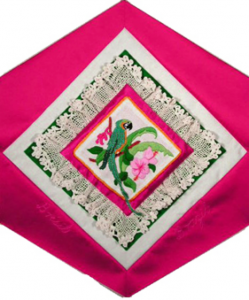Brazil

The Block
The vibrant and colourful images of the Brazil block, made by Saica Hincke and Jeannette Schaak, bring to mind the luscious beauty of the tropics, and reflect the exuberant nature of Brazilians. Set against a pink satin backdrop, a blue macaw surrounded by foliage and blossoms is embroidered onto a linen background. Satin is an important fabric in Brazil, used in the making of elaborate costumes worn during the country’s many carnivals and celebrations. It is fitting that needlework is incorporated into this piece since it is a way many Brazilians earn their living. Macaws, so called because they feed on the fruit of the macaw palms, are the largest member of the parrot family and are commonly found in many parts of Brazil. The pink hibiscus, prevalent in courtyards and Brazilian gardens, symbolizes the country’s lush vegetation. A border of filet lace with crocheted edging completes the design. Filet lace work, a traditional art form characteristic of the Alagoas in northeastern Brazil, reflects the simplicity of the warm and humble Brazilians and is often used by women to create geometrical or floral designs in fishing nets.
Cultural Profile
Brazil, the world’s leading producer of coffee, is located in the central-eastern part of South America. It makes up nearly one-half of the continent and is the fifth largest country in the world. Brazil is a nation of contrasts: from the sprawling Amazon rainforests (the world’s largest) to the parched northeast desert; from the hustle and bustle of Rio de Janeiro to sparsely populated, remote villages. The official language is Portuguese, a legacy of the Portuguese rule in the country that ended in 1822.
Brazilians are a friendly, hospitable, uninhibited people who enthusiastically embrace life. The many festivals that are an important part of their culture include the Festas Juninas (June Festivals) and the world-renowned and arguably the most exuberant, four-day Carnival held each year before Lent. People spend months making elaborate costumes and floats for the occasion. Also recognized internationally are many types of Brazilian music including the samba, the bossa-nova (a combination of samba and jazz) and Chorinho.
The Portuguese influence has been strong in all aspects of the culture, visible in its architecture, its art and its literature. The strong Roman Catholic legacy of the Portuguese permeates many aspects of life in the country. Yet, Brazil is also a multicultural country where African and indigenous cultures have made important contributions in Brazilian folklore, art and music. One distinctly Brazilian cultural item that shows a strong connection to its African roots is the capoeira, a sport that incorporates elements of martial arts and dancing.
As Brazil is the fifth largest cotton producer in the world, and has access to a large, well-trained workforce, the garment and textile industry are very strong in Brazil. The textile arts include Brazilian embroidery which is distinctive because of its use of rayon floss and its dimensional and highly textured appearance. This style, first popularized in Brazil, has spread worldwide. The designs used are very often floral or floral-inspired. The vast territory of the country, with its diversified climate and various cultural inputs, means that there is no typical national dress in Brazil. The southern plains are home to gauchos dressing like their Argentinian counterparts, the women of the state of Bahia are known for their long cotton skirts, while Indigenous people wear their traditional attire dictated by the climate and practice face painting, either in everyday life or on special occasions.
Brazilians have been coming to Canada since 1942. Only recently, however, have they arrived in significant numbers, due in part to the severe economic crises of the 1980s. Most Brazilians settled in southern Ontario’s urban centres because of employment opportunities. As of 2011, their numbers stood over 25,000.
Brazilian culture has greatly influenced Canada. Academies in Halifax, Toronto, and Hamilton have been formed to teach capoeira. The Brazilian Carnival Ball, celebrating Brazil’s popular holiday, has become a major annual social event in Toronto. Brazilian music and dance are also very popular and Toronto is home to several professional bands such as Banda Dá, and the Unidos do Canada, who often perform at the well-known Caribana festival.
Sponsor: Norman & Jeannette Schaak
